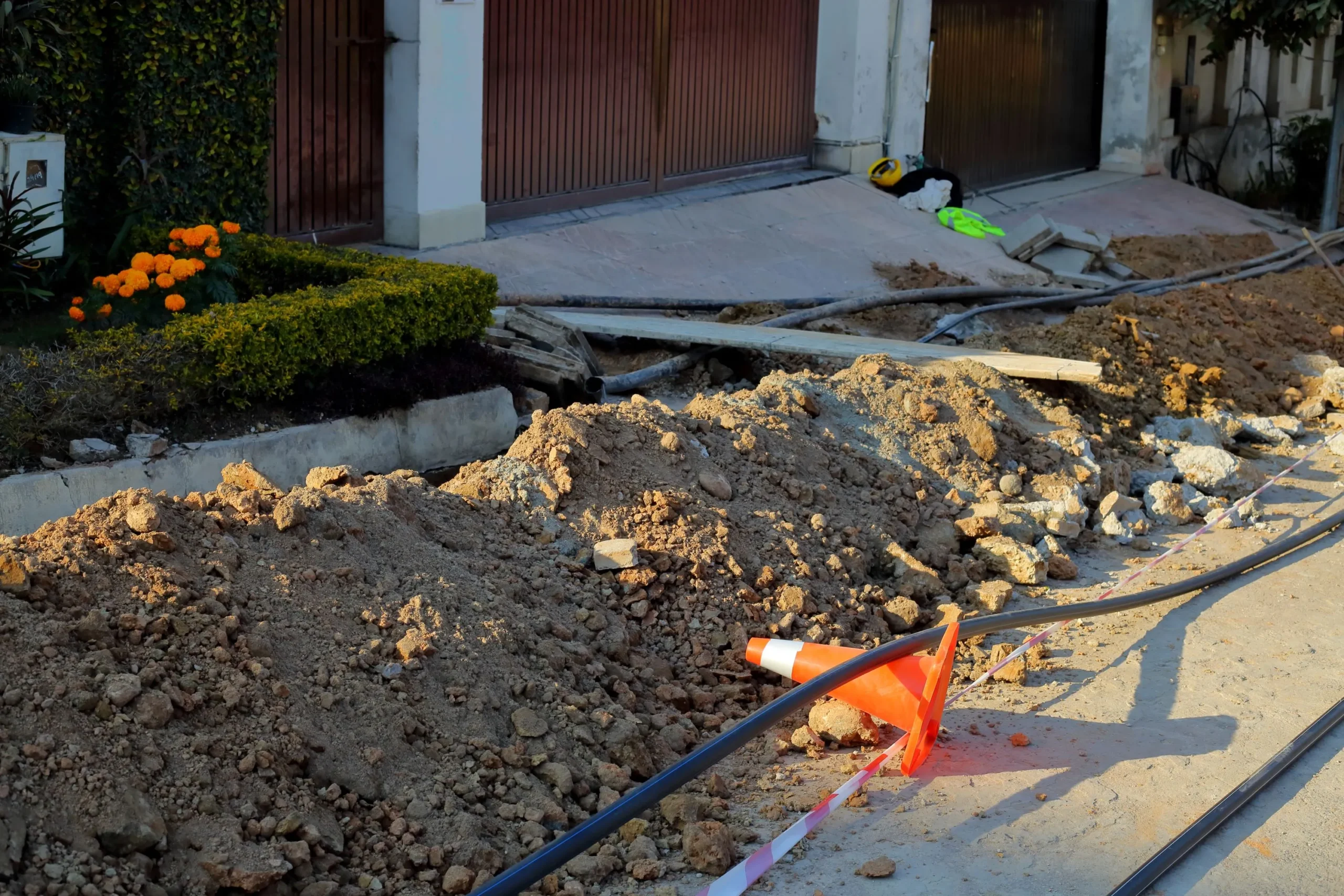You did everything right. You saw the ads promising lightning-fast “gig-speed” internet, you signed up, and you even upgraded your router. You’re paying for a premium connection, the kind that’s supposed to leave buffering wheels and lagging video calls in the dust.
So why does your 4K movie still freeze at the most dramatic moment? Why does your work video call stutter the second someone else in the house starts gaming online?
If you’ve ever felt like the speed you pay for isn’t the speed you actually get, you’re not wrong—you’re just starting to ask the right questions. The internet service industry has spent years focusing our attention on a single, dazzling number. But the truth is, that headline speed is only half the story. The real-world performance, reliability, and capability of your internet connection are determined by something far more important: the underlying network architecture.
As fiber experts, we believe you deserve to know what’s happening behind the scenes. It’s time to pull back the curtain and show you what’s really powering your digital life. This guide will empower you to see past the marketing and understand what truly creates a seamless and powerful internet experience.
Feel free to jump to areas that interest you the most:
- Decoding the hype: What does ‘up to 1 gig’ actually mean?
- The blueprint of your connection: A guide to network architectures
- How the right architecture transforms your digital experience
- An even deeper dive: Why latency matters more than you think
- What does it mean to be ‘future-proof’?
- The future-proof choice: The Quantum Fiber advantage
- Your checklist: Five questions to ask any internet provider
- Don’t just buy speed. Invest in a better connection.
Key takeways
- Advertised Speed vs. Real-World Speed: The “up to” speed you see in ads is a best-case scenario. Your actual speed is affected by your home WiFi setup, device capabilities, physical obstructions, and network congestion.
- Architecture is Key: How the internet is delivered to your home (the network architecture) is more critical for performance and reliability than the advertised speed number alone.
- FTTH is a Direct Connection: Fiber-to-the-Home (FTTH) provides a direct fiber-optic line to your house, resulting in a stable, reliable connection. This differs from Hybrid Fiber-Coaxial (HFC), or cable, which uses shared copper lines for the final stretch.
- Symmetrical Speeds Matter: For modern activities like video calls, cloud backups, and content creation, having an upload speed that matches your download speed is crucial. This is a primary benefit of most fiber-optic plans.
- Low Latency Creates a “Fast” Feeling: Beyond pure speed (bandwidth), low latency is what makes your internet feel responsive, especially for online gaming, web browsing, and real-time communication.
Decoding the hype: What does ‘up to 1 gig’ actually mean?
That little phrase, “up to,” does a lot of heavy lifting in internet advertisements. It’s a qualifier that means the advertised speed represents the absolute best-case scenario, measured under ideal laboratory conditions. It’s not a guarantee of the speed you will experience day-to-day. In reality, the final speed that reaches your device is affected by several factors right inside your own home. Even with the best connection coming into your house, your speed can be influenced by:
- WiFi vs. a hardwired connection: A direct, physical connection using an Ethernet cable from your router to your device will always deliver the most reliable and fast speed. WiFi, while convenient, is susceptible to signal loss and interference.
- Physical obstructions: WiFi signals can be weakened or blocked by walls (especially concrete and brick), floors, large metal appliances (like refrigerators), and even fish tanks.
- Distance from your router: The farther your device is from your WiFi router, the weaker the signal will be, resulting in slower speeds.
- Interference from other devices: Common household electronics like microwaves, cordless phones, and even your neighbor’s WiFi network can interfere with your signal.
- The age and capability of your device: An older smartphone or laptop may not have a network card or WiFi chip capable of handling the full gig-speed you’re paying for.
- Network congestion: Just like a highway, the internet can get busy during peak hours (usually evenings), which can sometimes affect speeds.
But the biggest factor that marketing often obscures is the difference between your download and upload speeds. This brings us to the unsung hero of a great internet connection: symmetrical speed.
Symmetrical vs. asymmetrical speeds: The hidden imbalance
For years, internet usage was mostly about consumption. We downloaded files, browsed websites, and streamed videos. Internet providers built their networks accordingly, creating what is known as an asymmetrical connection.
- Asymmetrical connection: This model provides a high-speed lane for data coming down to your home but a much smaller, slower lane for data going up from your home. Think of it like a ten-lane superhighway leading into a city, but only a single-lane dirt road leading out. For a long time, this was mostly fine.
Today, however, we are all creators. We don’t just consume data; we send it.
- We work from home: Participating in a high-definition video conference on Zoom or Teams requires sending a constant, high-quality stream of your own video and audio up to the cloud.
- We are content creators: Live streaming gameplay on Twitch, uploading a 4K video to YouTube, or posting high-resolution photos to Instagram all depend heavily on upload speed.
- We use the cloud: Syncing large work files to Google Drive or OneDrive, or automatically backing up your computer and phone to services like iCloud or Dropbox, are all upload-intensive tasks.
When your upload speed is only a tiny fraction of your download speed, you feel it. Your video calls could become pixelated, your game stream could lag, and that simple file backup takes forever.
This is where a symmetrical connection changes everything.
Symmetrical connection: This model, made possible by the high capacity of a fiber-optic network, provides equally fast—or very close to equal—speeds for both downloading and uploading. On most fiber plans, this means the ten-lane highway leading into the city is matched by a ten-lane highway leading out. It’s a balanced system built for the way we use the internet now.
The blueprint of your connection: A guide to network architectures
So, why can one “gig” plan offer symmetrical speeds while another can’t? The answer lies in the physical infrastructure—the blueprint of the network that runs from the provider’s central hub all the way to your home. Let’s break down the three main types.

Fiber-to-the-home (FTTH): The direct connection
This is the gold standard of modern internet connectivity. As the name implies, a fiber-optic line runs directly from the central source to a port in your home.
- How it works: Fiber-optic cables are made of tiny, pure strands of glass. They transmit data using pulses of light, which can travel for enormous distances with virtually no signal degradation. Because light is incredibly fast and efficient, this method offers unparalleled performance. Think of it as your own private, express superhighway with no off-ramps, traffic jams, or speed traps, leading directly to your front door.
- Key advantages of FTTH:
- Incredible speed: Capable of delivering not just one gig, but multi-gig symmetrical speeds.
- Symmetrical performance: Symmetrical or near-symmetrical speeds are a native capability, with most plans offering equally fast uploads and downloads.
- Reliability: Fiber optic cables are resistant to weather, temperature fluctuations, and electromagnetic interference.
- Ultra-low latency: Latency (or ping) is the delay it takes for a signal to travel from your computer to a server and back. Because data travels nearly at the speed of light on fiber, latency is incredibly low, which is critical for gaming and real-time communication.
- Future-proof: The bandwidth capacity of fiber is almost limitless. The cable being installed today will be able to handle the speed demands of tomorrow and beyond simply by upgrading the equipment at either end.

Hybrid fiber-coaxial (HFC): The ‘shared’ connection (cable)
This is the most common architecture used by cable internet providers. It’s a mix of old and new technology. A high-capacity fiber-optic line runs to a central node in a neighborhood, but from there, the connection is split among many homes using the same type of coaxial copper cable traditionally used for cable TV.
- How it works: This “last mile” of coaxial cable is a shared resource. All the homes connected to that node are sharing the same bandwidth. Imagine that superhighway ending a mile from your house, forcing all the traffic onto the same congested two-lane road for the final stretch home. During off-peak hours, it might feel fast. But during “internet rush hour” (typically evenings and weekends), when everyone is streaming, gaming, and working, that shared road gets jammed, and everyone’s speed slows down.
- Inherent weaknesses of HFC:
- Shared bandwidth: Your connection speed is directly impacted by your neighbors’ usage. This is also known as a high “contention ratio.”
- Asymmetrical by design: The underlying technology (DOCSIS) was built for television delivery (download-heavy) and is not designed for symmetrical speeds. While some providers are working on solutions, they are often complex and not widely available.
- Latency: The signal conversion from light (fiber) to electricity (coax) and the nature of the shared cable network can introduce delay.
- Susceptibility to interference: Coaxial copper cables can be prone to signal degradation from weather and radio frequency interference.
Digital subscriber line (DSL): The legacy connection
DSL technology brought internet to the masses by using the existing copper telephone lines already running to nearly every home.
- How it works: It sends data over the phone lines at a frequency that doesn’t interfere with voice calls. While revolutionary in its day, the technology is severely limited by the physical properties of copper wire.
- Limitations of DSL:
- Speed degradation: The signal weakens significantly over distance. The farther your home is from the provider’s central office, the slower your connection will be.
- Limited bandwidth: DSL simply cannot compete with the data-carrying capacity of HFC or, especially, FTTH networks. It may not be able to deliver speeds required for a modern connected home.
How the right architecture transforms your digital experience
Understanding the technology is one thing, but how does it actually impact your daily life? Let’s connect these technical blueprints to the real-world activities you care about most.
For power users and gamers:
For a serious online gamer, two metrics are often even more important than raw speed: latency and jitter.
- Latency (ping): The time it takes for your action (like clicking a mouse) to register on the game server and return. High latency is what you might feel as “lag,” where your character seems to react a split-second after you give a command.
- Jitter: The variation in your latency over time. A connection with high jitter feels unstable and unpredictable, with sudden lag spikes that can ruin a competitive match.
A Fiber-to-the-Home (FTTH) network, with its direct light-based connection, offers low latency and a stable, virtually jitter-free experience. This can give you a tangible competitive edge and helps ensure your gameplay is smooth and responsive.
For remote workers and small businesses: The mission-critical advantage
In a professional setting, internet isn’t just a utility; it’s the foundation of your productivity.
- Symmetrical speeds for collaboration: When you’re on a video call with a client, the clarity of your video and audio depends entirely on your upload speed. Fast symmetrical speeds help ensure you come through crystal clear, projecting professionalism. It also means you can upload large project files to a shared cloud drive in seconds, not minutes (or hours).
- Reliability for uptime: A stable FTTH connection keeps working even during peak hours. This means you can count on your connection to be there when you need it for that critical sales presentation or deadline, giving you peace of mind and helping protect your bottom line.
For the modern smart home and streamer
Your home is a bustling hub of digital activity. It’s no longer just one computer online; it’s a symphony of connected devices.
- Massive bandwidth for multitasking: A true fiber connection has the massive bandwidth needed to handle just about everything at once. You can stream a 4K movie in the living room while your partner is on a video call in the office, your kids are gaming in their rooms, your smart security cameras are uploading to the cloud, and dozens of other IoT devices are running in the background. An FTTH network doesn’t break a sweat, helping ensure your experience is smooth.
An even deeper dive: Why latency matters more than you think
We’ve talked about bandwidth, measured in megabits per second (Mbps) or gigabits per second (Gbps) and latency measured in microseconds (ms), but it’s crucial to understand their distinct roles. If bandwidth is the width of your digital highway, latency is the speed limit on that highway.
Imagine you need to send a single car (a small packet of data) from your home to a nearby destination and back.
- A wide, 20-lane highway (high bandwidth) with a 25 mph speed limit (high latency) will feel sluggish for this task. The car will take a long time to make the round trip, even though the road is huge. This is what happens on some cable networks; you have a big pipe, but the response time is slow.
- A narrow, 2-lane road (lower bandwidth) with a 250 mph speed limit (low latency) will feel incredibly fast for this single car. It will complete its round trip almost instantly.
This is why a fiber connection can feel fast even in basic web browsing. Every click you make—loading a webpage, sending a message, starting a search—is a small data packet that needs to make a round trip. Low latency makes the entire internet experience feel snappy and responsive. High bandwidth is what allows you to send millions of cars down the highway at once without a traffic jam.
You need both. But for the feeling of a fast connection, low latency is the secret ingredient that fiber delivers.

What does it mean to be ‘future-proof’?
The term “future-proof” gets thrown around a lot, but what does it actually mean for your internet connection? It means investing in an infrastructure that can handle the demands of technologies that are just on the horizon.
The data consumption of the average household is growing exponentially. What seems excessive today will be the baseline tomorrow. Consider these emerging technologies:
- 8K streaming and beyond: 8K video streams require roughly four times the bandwidth of 4K. As this becomes standard, networks will be under immense strain.
- Cloud gaming: Services like GeForce NOW and the future of Xbox Cloud Gaming aim to stream games at the highest fidelity with near-zero latency. This requires a massive, stable, and symmetrical data flow.
- The metaverse and AR/VR: True virtual and augmented reality experiences require persistent, high-bandwidth, and ultra-low-latency connections to render complex worlds in real-time. This is perhaps the most demanding application for a residential internet connection.
- Advanced smart homes (IoT): Your current smart home may have a few dozen devices. The home of the near future will have hundreds—from appliances and lighting to security sensors and environmental controls—all communicating constantly.
A hybrid-fiber network is already struggling to keep up with the demands of today. An FTTH connection has architecture with the foundational capacity to handle the world of tomorrow without needing to replace the physical lines running to your home.
The future-proof choice: The Quantum Fiber advantage
It should be clear by now that not all internet is built the same. The difference between a frustrating online experience and a seamless one often comes down to that physical line running into your home.
Because we believe in providing a connection you can count on, Quantum Fiber is built on a 100% Fiber-to-the-Home network. To deliver our advertised speeds to certain locations, we may utilize alternative technologies for the final portion of the connection. However, our commitment to a core fiber infrastructure means you’re getting a direct line built not just for the internet of today, but for the demands of tomorrow. This architectural choice is what allows us to deliver a high-performance connection built for modern demands.
We’ve designed our service tiers to be straightforward solutions for every type of user:
- Up to 500 Mbps: This symmetrical plan is great for busy households, providing more than enough power for seamless 4K streaming, online learning, and a home full of connected smart devices. And with unlimited data, you can use the internet as much as you want without worrying about overage fees.
- Up to 940 Mbps: Our most popular choice for prosumers, serious gamers, and remote professionals. This symmetrical gig-speed plan provides the elite performance and reliability needed for data-intensive work and play, all with unlimited data and no data caps.
- Multi-Gig (up to 2, up to 3, and up to 8 gig): For the ultimate power user, data-driven business, or tech enthusiast in select locations, our multi-gig plans offer speeds that were once unimaginable. Most of our plans are symmetrical, and all are built to unleash true creative and professional potential by eliminating bandwidth as a bottleneck to your ambitions. Of course, all plans come with unlimited data.

Your checklist: Five questions to ask any internet provider
Now that you’re armed with this knowledge, you can be a more discerning shopper. Before you sign up for any service, here are five crucial questions to ask:
- Is this a 100% Fiber-to-the-Home network, or a hybrid-fiber (HFC) network? This is the most important question.
- Are your advertised speeds symmetrical? Ask them to specify the upload and download speeds for the plan you’re considering. Don’t settle for just the download number.
- What is the typical network latency? While they may not give a guaranteed number, a provider proud of their low latency will have an answer ready.
- Is there a data cap? Some providers impose a limit on how much data you can use per month, which can be a major issue for streamers and remote workers.
- What does the installation process involve? Understanding how the service will physically enter your home can tell you a lot about the technology being used.

Don’t just buy speed. Invest in a better connection.
The internet is no longer a simple utility; it’s the invisible infrastructure that underpins our work, our entertainment, our communication, and our creativity. For too long, the conversation has been oversimplified to a single, often misleading, number.
The next time you see an internet ad, look past the headline speed and ask about the architecture. You now know the profound difference between a, hybrid connection built on legacy technology and a fiber line built for the future.
You’re not just a consumer; you’re an informed user who deserves an internet experience that is as powerful and reliable as the technology it’s built on.
Ready to experience the FTTH difference? Check for service availability at your address.
Content Disclaimer – All content is for informational purposes only, may require user’s additional research, and is provided “as is” without any warranty, condition of any kind (express or implied), or guarantee of outcome or results. Use of this content is at user’s own risk. All third-party company and product or service names referenced in this article are for identification purposes only and do not imply endorsement or affiliation with Quantum Fiber. If Quantum Fiber products and offerings are referenced in the content, they are accurate as of the date of issue. Quantum Fiber services are not available everywhere. Quantum Fiber service usually means 100% fiber-optic network to your location but, in limited circumstances, Quantum Fiber may need to deploy alternative technologies coupled with a non-fiber connection from a certain point (usually the curb) to your location in order to provide the advertised download speeds. ©2025 Q Fiber, LLC. All Rights Reserved. Quantum, Quantum Fiber and Quantum Fiber Internet are trademarks of Quantum Wireless LLC and used under license to Q Fiber, LLC.








